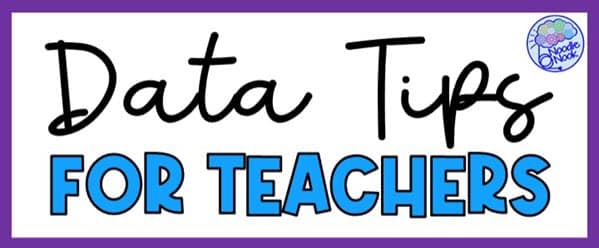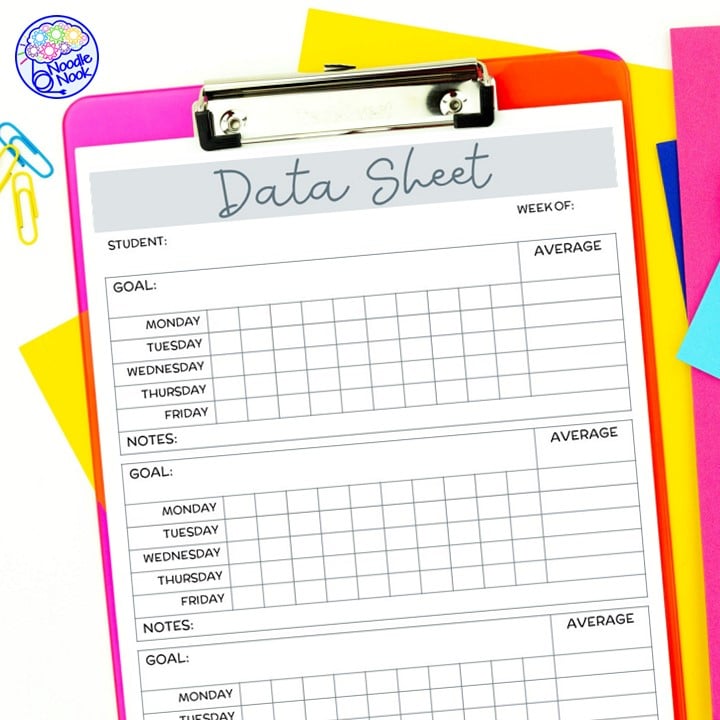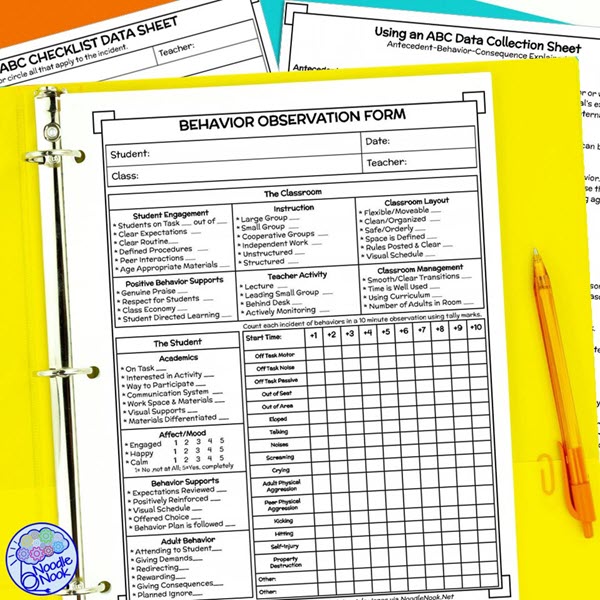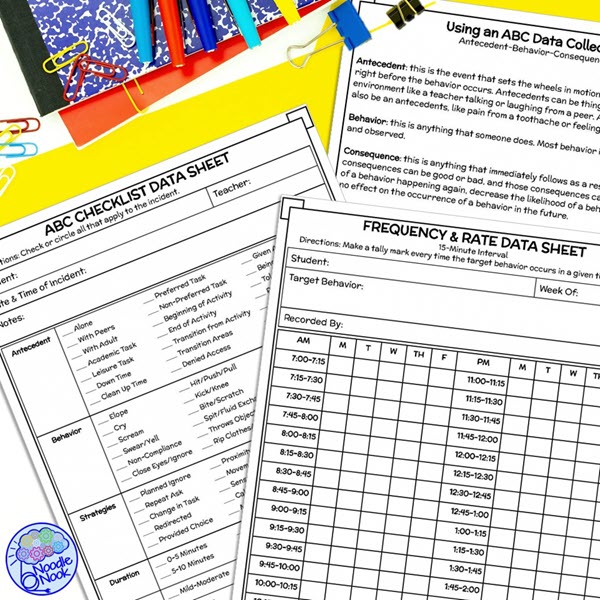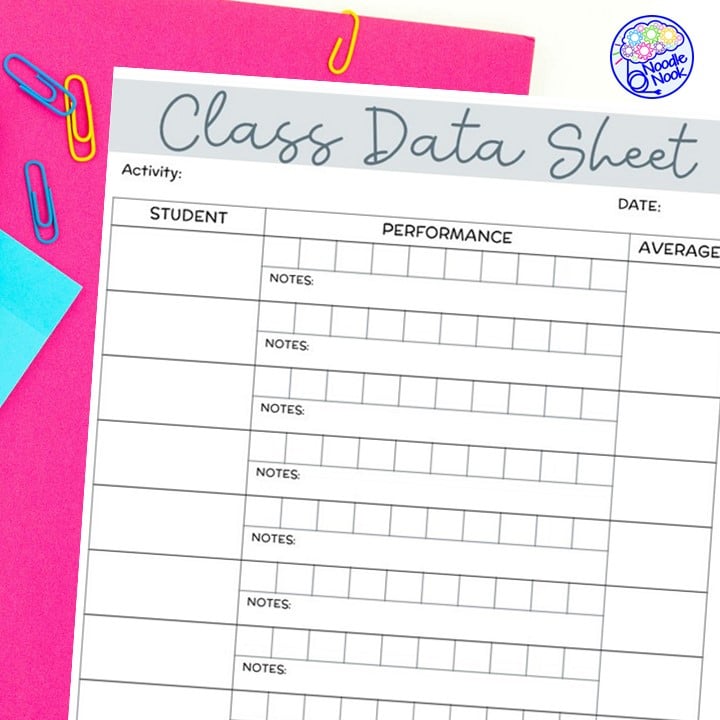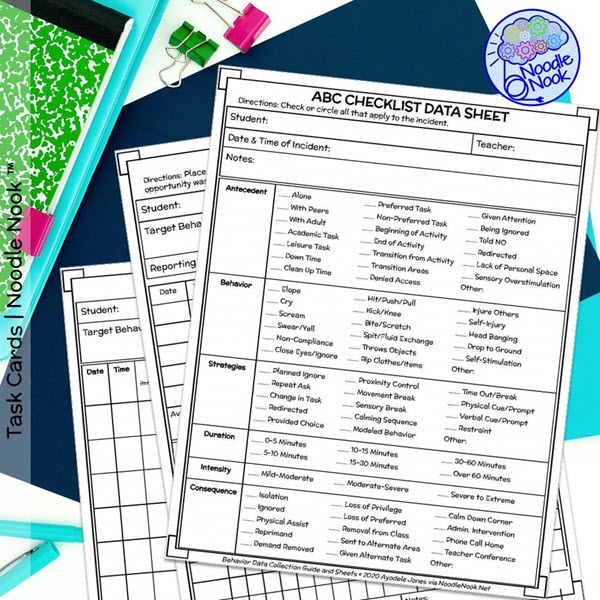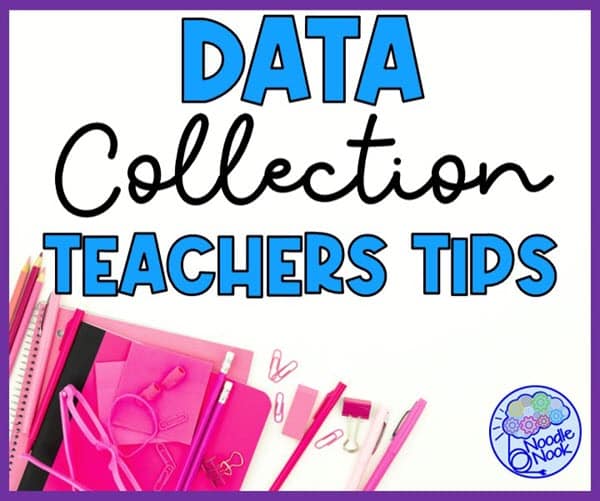Hey there, awesome teachers in special education! Are you ready to conquer data collection like a pro? Does the mention of the word ‘data’ have you grimacing and annoyed? Don’t worry, I’ve got some tips up my sleeve that will make tracking progress a breeze! Let’s tick some boxes and discover how to make data fun-ish with some data collection tips for teachers in special education. Ready? Let’s go!
Step 1: Set Clear Goals and Objectives 🎯
Start by setting clear goals and objectives for your students. Think about what you want them to achieve and how you’ll measure their progress. Keep it specific, like “Johnny will improve reading fluency by 10 words per minute in three months.” This way, you’ll know exactly what data to collect.
HOW TO:
✅ Include Students and Parents 🤝 Discuss the goals with your students and their parents or guardians. Listen to their input and consider their aspirations for the child. When students feel included in the goal-setting process, they are more motivated to achieve the objectives. This collaboration also fosters a sense of support and teamwork between teachers, students, and parents.
✅ Break Down Goals into Achievable Steps 🚶 Divide the larger goals into smaller, manageable milestones. Create a step-by-step plan with clear criteria for success at each stage. Breaking down goals helps students and educators track progress more effectively and identify areas that might need additional support.
✅ Utilize SMART Goal Criteria 🧠 Make sure your goals are Specific, Measurable, Attainable, Relevant, and Time-bound (SMART). Specific goals clearly define what the student aims to achieve, measurable goals provide a way to track progress, attainable goals are realistic and feasible, relevant goals align with the student’s needs, and time-bound goals have a set timeframe for achievement.
🔍 TRY THIS:
Looking for inspiration in creating specific goals? Check out the blog post series on IEP goal banks, where you can find a wealth of pre-written, individualized goals designed for various learning needs. These goal banks can save you time and effort while ensuring your objectives align with the unique requirements of each student’s Individualized Education Program (IEP). Start here with this post on IEP Goal Banks.
Step 2: Choose the Right Tools 🛠️
Next up, pick the right tools for data collection. Whether it’s simple pen and paper or digital apps, find what works best for you. Don’t be afraid to experiment with different methods until you find your perfect fit. Remember, it’s all about making your life easier!
HOW TO:
✅ Use Data Collection Apps 📱💻 Take advantage of all the tech around us by using data collection apps. Look for ones that offer user-friendly interfaces and possibly pieces tailored to special education. Some apps may allow you to record observations, track progress, and easily generate reports.
✅ Try Visual Aids and Checklists 📋👀 Visual aids and checklists can be excellent alternatives to digital tools. Create personalized checklists or use visual tracking charts that students can understand and interact with easily. These tactile methods can be especially beneficial for students who thrive with hands-on learning experiences.
✅ Check in With Colleagues 🤝👩🏫 Talk with your fellow educators and sped peeps to learn about the tools they use for data collection. Share your experiences and learn from theirs. You might discover innovative tools or creative ways to adapt existing ones for specific needs.
🔍 TRY THIS:
Seeking some practical data collection tool recommendations? Check out this blog post on How to Setup Data in the Classroom.
Step 3: Keep It Consistent 🔄
Consistency is the key to success! Make data collection a regular part of your routine. Set aside a few minutes each day or week to record your observations. By doing this regularly, you’ll spot trends and progress more easily, helping you tailor your teaching strategies for each student.
HOW TO:
✅ Have a Data Collection Schedule 🗓️🕰️ Be sure you have a consistent data collection schedule that fits into your daily or weekly routine. Dedicate specific times to record observations and progress for each student. Stick to this schedule diligently to ensure you never miss crucial data points.
✅ Set Reminders and Alarms ⏰📅 Set up reminders and alarms on your phone or computer to prompt you when it’s time to collect data. These gentle nudges will help you stay on track, especially on busy days when data collection might slip your mind.
✅ Get Help from Support Staff 🤝👨🏫 Yup, you don’t need to collect alone! Get support staff, teacher assistants, or aides included in the data collection process. Delegate specific data recording responsibilities to guarantee consistency (and accountability), especially during times when you might be occupied with other teaching tasks.
🔍 TRY THIS:
Need additional tips on how to do your data? I love this behavior data sheet resource because it has guide sheets. Each version of the data includes an explanation, help with calculations, and help on how to choose the right one. Yeah!
Step 4: Involve Your Students 🤝
Data collection doesn’t have to be a one-person show! Involve your students in the process. They can track their progress too, which empowers them and fosters a sense of ownership over their learning journey. Plus, they might even enjoy it when they see how much they’ve grown!
HOW TO:
✅ Set Clear Goals Together 🎯🤝 Hold a sit-down session with your students to set clear, achievable goals. Discuss their strengths, areas for improvement, and what they want to achieve. When students have a say in their objectives, they become more invested in the learning process.
✅ Use Progress Trackers 📈🚀 Provide students with visual progress trackers that they can update regularly. These can be charts, graphs, or simple checklists where they mark their accomplishments. Celebrate milestones together to acknowledge their efforts.
✅ Encourage Self-Reflection 🤔📝 Seems a little granola-y, but we all have to think about our goals, our progress, and long-term wants. Incorporate regular self-reflection activities where students can assess their own progress. Even as adults, goal setting is essential along with tracking our own progress. Reflecting is an important skill.
🔍 TRY THIS:
Want more ideas on student involvement in data collection? Us too! Head over to Instagram and post an idea, then tag us! We’d love to see what you’re up to @thenoodlenook.
Step 5: Analyze and Celebrate 🎉
Now that you’ve collected your data, it’s time to analyze it! Look for patterns, improvements, and areas that need more attention. Celebrate the victories, both big and small, with your students. Positive reinforcement goes a long way in boosting their confidence and motivation.
HOW TO:
✅ Review Data Regularly 📊🔍 Set aside dedicated time to review the data you’ve collected. Look for patterns and trends in student progress. Identify areas where students have made significant improvements and areas that may require additional support or adjustments to your teaching strategies. I love self-graphing data sheets for an easy way to see what’s up as you record data.
✅ Praise Effort and Progress 🌟🏆 Celebrate both big and small victories with your students. Praise their efforts, hard work, and progress toward their goals. And, yes. You got that right. We praise effort. Sometimes what holds people back is the fear of failure… so praise effort. Recognize their determination and growth, even if they haven’t reached the final objectives yet. Trying is part of the process!
✅ Involve the Whole Class 🗣️🎉 Share success stories and achievements with the entire class. Create a supportive and encouraging atmosphere where students can cheer for their peers’ accomplishments. Teamwork makes the dream work, right?
🔍 TRY THIS:
I love to celebrate when students work hard and make progress. It’s always amazing to me how hard a student will try when they know you’re watching and sharing success. I’m also shocked at how excited people get when I write a happy note home. Looking for some happiness to share? Try These with the Behavior Visuals resource.
Bonus Tip: Stay Flexible and Have Fun! 🎉
Remember, data collection should never be stressful. Stay flexible and adapt your methods as needed. And most importantly, have fun with it! Maybe create a fun chart or use stickers to reward progress. Embrace the journey, and you’ll see how data can be your new best friend in special education!
RECAP: Data Collection Tips for Teachers
So, there you have it, amazing teachers! Follow these five easy steps, and you’ll become a data collection pro in no time. Or at least not let data drive you over the edge. Let’s track progress, celebrate achievements, and make a real difference in our students’ lives. You’ve got this! 🌟

